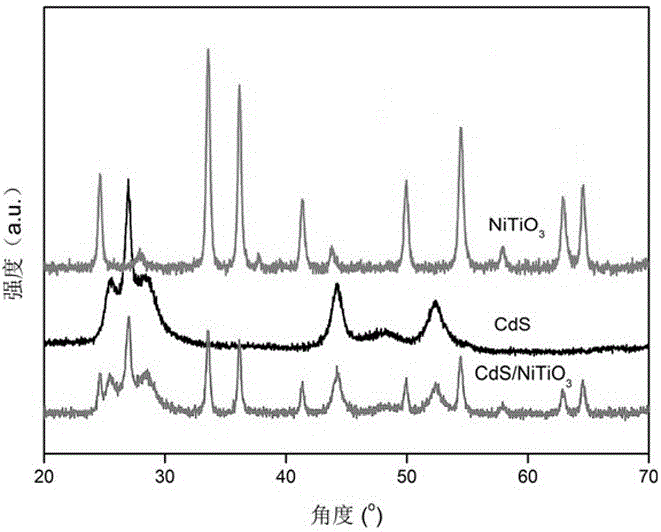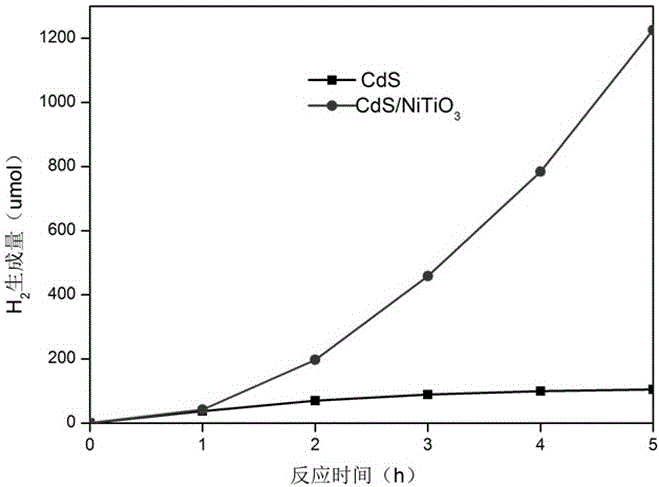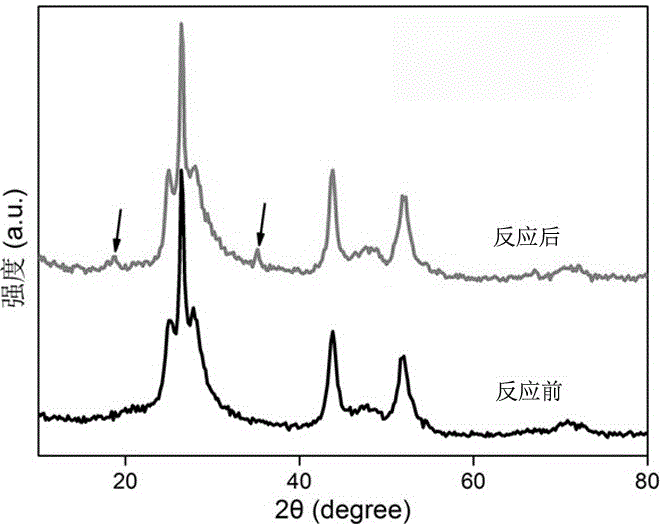Composite photocatalyst for promoting water photolysis for producing hydrogen
A technology of composite light and catalyst, applied in physical/chemical process catalyst, hydrogen production, hydrogen and other directions, can solve the problems of poor stability, low quantum efficiency, low activity, etc. Effect
- Summary
- Abstract
- Description
- Claims
- Application Information
AI Technical Summary
Problems solved by technology
Method used
Image
Examples
Embodiment 1
[0024] Example 1 NiTiO 3 preparation of
[0025] 2.48g of nickel acetate tetrahydrate (Ni(CH 3 COO) 2 4H 2 O) Dissolved in 60mL ethylene glycol solution, after fully dissolved, 3.4mL tetrabutyl titanate (Ti(OC 4 h 9 ) 4 ) was added dropwise to the above solution, stirred at room temperature for 1 h, the resulting green precipitate was washed with ethanol, dried, and calcined at 600 °C for 2 h in an air atmosphere to obtain NiTiO 3 .
Embodiment 2
[0026] Example 2 CdS / NiTiO 3 Preparation of composite catalyst
[0027] The NiTiO that 0.5g embodiment 1 obtains 3 Disperse in 70mL DMF solution, then add 8.7mL 0.2M DMF solution containing cadmium acetate and 8.7mL 1M DMF solution containing thiourea to the above solution, stir at room temperature for 30min, then condense the solution at 160°C to reflux 12h, the resulting product was washed three times with ethanol and deionized water, and dried to obtain the desired CdS / NiTiO 3 composite photocatalyst.
Embodiment 3
[0028] Example 3 CdS / NiTiO 3 Activity Evaluation of Photolysis of Water for Hydrogen Production
[0029] Embodiment 2 gained CdS / NiTiO 3 The evaluation experiment of hydrogen production efficiency of composite photocatalyst by photolysis of water was carried out on the Pofilai photolysis device, and Shimadzu 8A gas chromatography was used to detect H 2 output. The experimental process is as follows: add 50 mg of the obtained composite photocatalyst to 70 mL of deionized water, and add 10 mL of lactic acid as a hole sacrificial agent, use a xenon lamp as the light source, and add a 420 nm cut-off filter to conduct photolysis of water on a photolysis water device. Reaction, the system is vacuumed, the reaction temperature is 5°C, and then the system is illuminated with visible light of λ>420nm, and the H in the system is detected every 1h. 2 content, the reaction was terminated after 5h.
[0030] figure 1 CdS, NiTiO 3 , CdS / NiTiO 3 The XRD comparison pattern. Such as fi...
PUM
 Login to View More
Login to View More Abstract
Description
Claims
Application Information
 Login to View More
Login to View More - R&D
- Intellectual Property
- Life Sciences
- Materials
- Tech Scout
- Unparalleled Data Quality
- Higher Quality Content
- 60% Fewer Hallucinations
Browse by: Latest US Patents, China's latest patents, Technical Efficacy Thesaurus, Application Domain, Technology Topic, Popular Technical Reports.
© 2025 PatSnap. All rights reserved.Legal|Privacy policy|Modern Slavery Act Transparency Statement|Sitemap|About US| Contact US: help@patsnap.com



